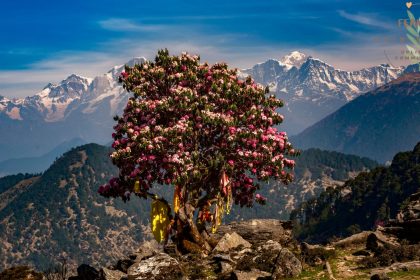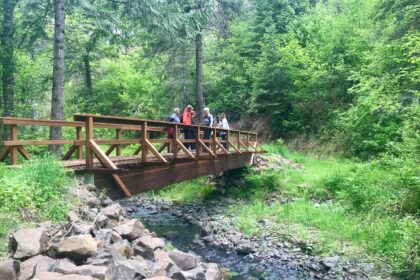Mel and I sat beside her tent, listening to the roar of the Grey Wolf River and talking about our work as wilderness therapy field guides. It had been a rough shift with hike strikes, unmedicated ADHD, and struggling new clients, but for now everyone was journaling in their tents and we had a moment’s reprieve.
Mel was drawing circles in the sand describing how constructive growth happens outside our comfort zone but not so far as to become destructive in nature. Our work as field guides is to help our clients become comfortable in their growth zone beyond their inner comfort zone.
 “It’s like a tree,” I said. “Do you know how trees grow?”
“It’s like a tree,” I said. “Do you know how trees grow?”
“Refresh me,” Mel replied.
Redrawing her circles, I said, “All the growth happens in a one-cell thick layer between the inner wood and the bark. The inner wood is like the comfort zone you drew, and the bark is our reaction to destructive experiences. But all the growth happens here, in this one-celled layer just beyond our comfort zone.”
It gets even better.
 Trees don’t grow up, they grow out. Meristem cells at the tips of branches and roots extend in the spring, and the cambium layer, which wraps around the entire tree, adds layers each year that show up as growth rings inside the tree. That’s why a tree will wrap itself around a wrought iron fence but it won’t tear that fence out of the ground and raise it up in the air, because the tree is only growing out from the tips of its buds and roots and expanding along its cambium layer.
Trees don’t grow up, they grow out. Meristem cells at the tips of branches and roots extend in the spring, and the cambium layer, which wraps around the entire tree, adds layers each year that show up as growth rings inside the tree. That’s why a tree will wrap itself around a wrought iron fence but it won’t tear that fence out of the ground and raise it up in the air, because the tree is only growing out from the tips of its buds and roots and expanding along its cambium layer.
The cambium layer is only one cell thick, but it wraps around the whole tree. Those cells divide into the inner bark (phloem) and the sapwood (xylem). The phloem is vascular tissue that brings sugars and other metabolic products down from the leaves. The xylem passes water and nutrients from the roots up to the rest of the tree.
When phloem cells die they become the hard, outer bark of the tree, protecting it from the outside world. When xylem cells stop transmitting nutrients they become part of the hard, inner heartwood of the tree.
 I think we develop psychologically in a very similar way. Or as I like to say, our souls grow like trees.
I think we develop psychologically in a very similar way. Or as I like to say, our souls grow like trees.
Our growth happens in this narrow, single-celled cambium layer that represents the Now that we all live in. It’s the present moment in which we experience life, and each moment divides to become the phloem and xylem of our psyche, or soul if you will.
Our phloem takes lessons learned from our experiences with the outer world and makes bark out of them. This is how we learn to protect ourselves and adapt ourselves to the world we are growing into. This is not negative or bad, it’s actually healthy and good. We need our bark to protect us. Without it, we would be vulnerable to disease and insects and harsh conditions, but with it, we can survive and even give back our life source to the world around us, as a tree gives back oxygen.
Of course, any tree with more bark than sapwood is struggling to survive.
Our xylem draws from the soil of our heritage, our history and upbringing and inner strength – our roots – to bring new experiences into our comfort zone. This is how we overcome challenges, learn new skills, and become comfortable in our relationships. This is our Sapwood. It’s still part of our growth, we are learning and adapting, but it’s growth we are comfortable with.
Once we stop adapting to the lessons we are learning, our Sapwood becomes Heartwood and forms our core beliefs. These are the things we have come to believe about ourselves and the world around us, so much so that we don’t even consider them on a conscious level anymore, we simply react based on them. It’s our core beliefs that give us rigidity and direction as we grow into the outer world, for better or worse.
The Now (cambium) becomes Growth (xylem/phloem) and solidifies into Character (bark/heartwood).
 A beautiful thing about the way trees grow is how resilient they are. You can’t kill a tree simply by driving a nail into its trunk or chopping off a limb. Even a stump will grow new shoots if the roots are whole. To kill a tree you have to completely sever the cambium layer, called girdling the tree, or destroy the roots. Even a stump will sprout new shoots as long if the roots are healthy.
A beautiful thing about the way trees grow is how resilient they are. You can’t kill a tree simply by driving a nail into its trunk or chopping off a limb. Even a stump will grow new shoots if the roots are whole. To kill a tree you have to completely sever the cambium layer, called girdling the tree, or destroy the roots. Even a stump will sprout new shoots as long if the roots are healthy.
 There was an old, gnarled tree in the Enchanted Valley that beautifully displayed the resilience of our souls. Something catastrophic happened to this tree. It had been gutted, torn in half, and a large portion of it was lying dead on the ground. Whole limbs had died, but new shoots sprang forth and where ever the cambium was still connected nutrients continued to flow from roots to leaves and back again.
There was an old, gnarled tree in the Enchanted Valley that beautifully displayed the resilience of our souls. Something catastrophic happened to this tree. It had been gutted, torn in half, and a large portion of it was lying dead on the ground. Whole limbs had died, but new shoots sprang forth and where ever the cambium was still connected nutrients continued to flow from roots to leaves and back again.
Some of our clients at Rites of Passage have faced this kind of trauma. Some of you reading this right now have, too. But as long as we’re alive, then our cambium layer is still intact, and like this tree, we can bloom anew.










[…] We are living in the cambium layer, growing souls like trees. We are pressing faith up against fear as we encounter the unknown and let it shape […]
[…] because we feel safer that way. But hiding will never set us free. Wilderness taught me that we grow souls like trees, meaning that we grow, not from a center hidden away in our comfort zone, but from our outer edges […]
[…] in July, and a few of us did lunch together on top of Coolwater Mountain in August. I learned how souls grow while serving as a wilderness therapy field guide. And finally, we brought the season to a close […]